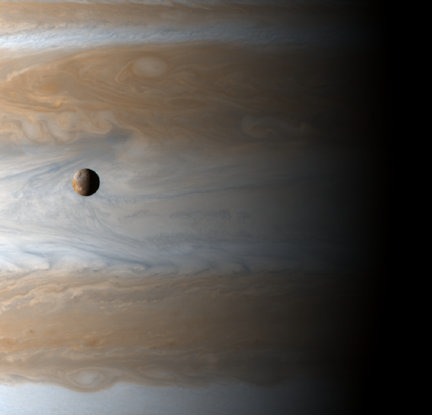The Universe Today readers are always asking great questions. ”How long is a day on Jupiter?”, is one of them. A day on Jupiter, also known as the sidereal rotation period, lasts 9.92496 hours. Jupiter is the fastest rotating body in our Solar System. Determining the length of a day on Jupiter was very difficult, because, unlike the terrestrial planets, it does not have surface features that scientists could use to determine its rotational speed.
Scientists cast about for ways to judge the planet’s rotational speed. An early attempt was to do some storm watching. Jupiter is constantly buffeted by atmospheric storms, so the theory was that you could locate the center of a storm and get some idea of the length of a day. The problem scientists encountered was that the storms on Jupiter are very fast moving, making them an inaccurate source of rotational information. Scientist were finally able to use radio emissions from Jupiter’s magnetic field to calculate the planet’s rotational period and speed. While other parts of the planet rotate at different speeds, the speed as measured by the magnetosphere is used as the official rotational speed and period.
All of the planets are oblate spheroids with varying degrees of flattening. Jupiter’s extremely fast rotation flattens it more than any other planet. The diameter of the equator is 9275 km more than the distance from pole to pole. Another interesting effect of Jupiter’s rotational speed is that, because Jupiter is not a solid body, its upper atmosphere features differential rotation. The atmosphere above the poles rotates about five minutes slower than the atmosphere at the equator.
Jupiter is almost a solar system unto itself. Many astronomers believe the the planet is simply a failed star, just lacking the mass needed to ignite fusion. Many people are aware of its four largest moons, the Galilean moons Io, Europa, Ganymede, and Callisto, but few realize that Jupiter has 50 confirmed moons and at least 14 provisional moons. The four largest moons are all very interesting to scientists. Io is a volcanic nightmare. Europa is covered in water ice and may have oceans of slushy ice underneath. Ganymede is the largest moon in the Solar System, even bigger than Mercury, and is the only moon known to have an internally generated magnetic field like Earth’s. Callisto is interesting because its surface is thought to be very ancient; perhaps original material from the birth of the Solar System.
Knowing ”how long is a day on Jupiter” just scratches the surface of the intrigue that is the Jovian system. You could spend months researching the planet and its moons, yet have more to research to do.
Here’s an article on Universe Today that shows how Jupiter can be very flattened, and an article about how the powerful windstorms are generated from its rotation.
NASA’s Ask an Astronomer also has an answer for the question, “how long is a day on Jupiter?” And a cool video of Jupiter’s rotation.
We’ve also recorded an entire show just on Jupiter for Astronomy Cast. Listen to it here, Episode 56: Jupiter, and Episode 57: Jupiter’s Moons.
Sources:
NASA
Caltech Cool Cosmos

